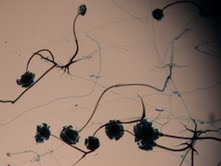The good, the bad, and the ugly!
The good:
Rhizopus stolonifer has some importance to the environment. This specific type of mold plays a key role in the carbon cycle because it works as a decomposer in the soil, dung, and many food types. It is able to recycle materials, like sugar and starch, in order to make use of what has previously been used. Rhizopus stolonifer causes rotting in fruits and some other foods, which is good because the compounds in the food are being reused instead of wasted. Scientists have also found that Rhizopus stolonifer can be used in medications, such as birth control pills. The mold is able to produce steroids within its cells, of which are commonly present in the pill.
The bad:
In most cases, the mold grows inside food while using extracellular enzymes to take up nutrients and dissolve the substrate in which it resides. Rhizopus stolonifer is a fast growing parasite that is selfish and absorbs all of the nutrients of the substrate, leaving it with nothing to live on.
The ugly:
Rhizopus stolonifer is a dangerous mold that can be found on the common bread that we, as humans, consume. In some cases, this mold causes infections in humans. If black bread mold is spotted on any type of bread in your house or if mold is found on soft fruits, it is important to discard of the matter as soon as possible to avoid any close contact. Children's sandboxes should be monitored regularly to make sure any mold or fungus that is found is cleaned up immediately to avoid any unwanted exposure.
To view additional information on types of human exposure please click here.
Proceed on to fun facts to learn more!

